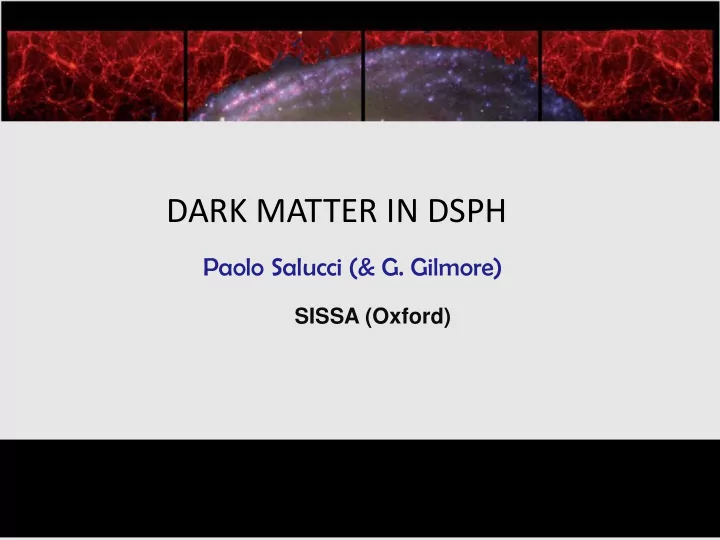

DARK MATTER IN DSPH Paolo Salucci (& G. Gilmore) SISSA (Oxford)
Outline of the Review Dark Matter is main protagonist in the Universe The concept of Dark Matter in virialized objects Dark Matter in Spirals, Ellipticals, dSphs Dark and Luminous Matter in dSph. Global properties. Phenomenology of the mass distribution in Galaxies. Implications for Direct and Indirect Searches
The Realm of Galaxies The range of galaxies in magnitudes, types and central surface densities : 15 mag, 4 types, 16 mag arsec -2 Central surface brightness vs galaxy magnitude Dwarfs Spirals : stellar disk +bulge +HI disk The distribution of luminous matter : Ellipticals & dwarfs E: stellar spheroid
What is Dark Matter ? In a galaxy, the radial profile of the gravitating matter M(r) does not match that of the luminous component M L (r). A MASSIVE DARK COMPONENT is then introduced to account for the disagreement: Its profile M H (r) must obey: M(r), M L (r), dlog M L (r)/dlog r observed The DM phenomenon can be investigated only if we accurately meausure the distribution of: Luminous matter M L (r). Gravitating matter M(r)
THEORY AND SIMULATIONS
Λ CDM Dark Matter Density Profiles from N-body simulations The density of virialized DM halos of any mass is empirically described at all times by an Universal profile (Navarro+96, 97, NFW). More massive halos and those formed earlier have larger overdensities Today mean halo density inside R vir = 100 ϱ c Klypin, 2010
SPIRALS
Evidence for a Mass Discrepancy in Galaxies The distribution of gravitating matter, unlike the luminous one, is luminosity dependent. Tully-Fisher relation exists at local level (radii R i ) Yegorova et al 2007
Rotation curve analysis From data to mass models observations = model ➲ from I-band photometry ➲ from HI observations ➲ different choices for the DM halo density Dark halos with central constant density (Burkert, Isothermal) Dark halos with central cusps (NFW, Einasto) NFW ISO The mass model has 3 free parameters: disk mass Burkert halo central density Halo core radius (length-scale) Obtained by best fitting method
MASS MODELLING RESULTS M I = - 21 M I = - 23 M I = -18 highest luminosities lowest luminosities halo disk disk halo halo disk All structural DM and LM parameters are related with luminosity.g fraction of DM Smaller galaxies are denser and have a higher proportion of dark matter. luminosi inosity
ELLIPTICALS
slide1 Coccato et al. 2009 NGC 4374 Napolitano et al. 2011 0 2 10 R/R e Velocity dispersion are flat or strongly decreasing outside ~2R e JEANS ANALYSIS There exist big DM halos around Ellipticals, Cored and cuspy DM WMAP1 profiles are both possible. MORE DATA
Mass Profiles from X-ray Nigishita et al 2009 Temperature Density M/L profile CORED HALOS? NO DM Hydrostatic Equilibrium
dSphs
Kinematics of dSph 1983: Aaronson measured velocity dispersion of Draco based on observations of 3 carbon stars - M/L ~ 30 1997: First dispersion velocity profile of Fornax (Mateo) 2000+: Dispersion profiles of all dSphs measured using multi-object spectrographs Instruments: AF2/WYFFOS (WHT, La Palma); FLAMES (VLT); GMOS (Gemini); DEIMOS (Keck); MIKE (Magellan) 2010: full radial coverage in each dSph, with 1000 stars per galaxy STELLAR SPHEROID
Dispersion velocity profiles STELLAR SPHEROID Walker, 2007 dSph dispersion profiles generally remain flat to large radii Huge model-independent evidence of mass-to-light discrepancy
Mass profiles of dSphs Jeans ’ models provide the most objective sample comparison Jeans equation relates kinematics, light and underlying mass distribution Make assumptions on the velocity anisotropy and then fit the dispersion profile PLUMMER PROFILE DENSITY PROFILE Results point to cored distributions Gilmore et al 2007
Degeneracy between DM mass profile and velocity anisotropy Cored and cusped halos with orbit anisotropy fit dispersion profiles equally well Walker et al 2009 σ (R) km/s
Global trend of dSph haloes Mateo et al 1998 Strigari et al 2008 Gilmore et al 2007 M=cost t
dSphs cored halo model halo central densities correlate with core radius in the same way as Spirals and Ellipticals Donato et al 2009
Virial Halo Masses correlate with the Masses of the Stellar Component Moster,+ 10 11 14 An unique mass profile M h (r) = G(r) ? Walker+ 09, 10 1 log r (pc) 5
GALAXY HALOS: AN UNIFIED VISION
Mass-to-Light ratios at half light radius R e in virialized objects Increase due to Reionization? Wolf et al. 2010 SN feedback? Stripping ? Spirals at R VIR s Derived from Jeans modelling Derived from FP Increase due to: AGN feedback? Virial heating? L * galaxies are most efficient at Globular clusters: turning initial baryonic content No DM! into stars. . Galaxies are increasingly DM dominated at lower and higher mass
DSPH: WHAT WE KNOW PROVE THE EXISTENCE OF DM HALOS OF 10 10 M SUN AND ρ 0 =10- 21 g/cm 3 DOMINATED BY DARK MATTER AT ANY RADIUS MASS PROFILE CONSISTENT WITH THE EXTRAPOLATION OF THE URC HINTS FOR THE PRESENCE OF A DENSITY CORE
WIMP mutual annihilations of WIMPs in DM halos would produce, on Earth, an indirect signature in a flux of high energy cosmic rays or photons. TRUE DM SIGNAL Sources: galactic center, MW satellites, nearby galaxies, clusters. FAKE ASTRO SIGNAL
Gamma ray flux on detector on Earth from DM annihilation in DM halos Astrophysics Particle Physics E =photon energy ΔΨ=detector acceptance σ =annihilation cross section v =wimp velocity Strong dependence m =wimp mass on specific DM halo B =branching ratio density profile N =photon spectrum in a given channel
Pieri et al 2010
Recommend
More recommend